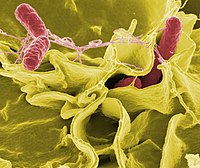
Photo from wikipedia
OBJECTIVE To determine the levels of interleukin-6 (IL-6) and tumor necrosis factor-α (TNF-α) gene transcription and protein expression in peripheral blood mononuclear cells (PBMCs) of children with bacterial and viral… Click to show full abstract
OBJECTIVE To determine the levels of interleukin-6 (IL-6) and tumor necrosis factor-α (TNF-α) gene transcription and protein expression in peripheral blood mononuclear cells (PBMCs) of children with bacterial and viral infectious diarrhea. STUDY DESIGN An observational study. PLACE AND DURATION OF STUDY Department of Pediatrics, Pingyi County People's Hospital of Shandong province, Pingyi, China, from January 2017 to February 2018. METHODOLOGY Children with bacterial diarrhea and children with viral diarrhea were assigned to respective bacterial and viral infection groups. The serum IL-6, TNF-α levels in the two groups were detected by ELISA. PBMCs were collected from study subjects, and mRNA transcription expression level of IL-6 and TNF-α in PBMCs of the two groups were determined by semi-quantitative reverse transcription-polymerase chain reaction (RT-PCR) technique, and IL-6 and TNF-α protein expression levels in PBMCs of the two groups were determined by Western blot analysis. RESULTS In a total of 50 children with bacterial diarrhea and 70 with viral diarrhea, the levels of serum IL-6, PBMCs IL-6 mRNA transcription and IL-6 protein expression were higher in the viral infection group than in the bacterial infection group (all p<0.001). The level of serum TNF-α and PBMCs TNF-α mRNA transcription and TNF-α protein expression were higher in the bacterial infection group than in the viral infection group (all p<0.001). CONCLUSION When it is difficult to clinically identify the pathogeny of pediatric diarrhea infection, adjuvant diagnosis can be made by virtue of IL-6 and TNF-α changes in the blood to choose the correct treatment.
Journal Title: Journal of the College of Physicians and Surgeons--Pakistan : JCPSP
Year Published: 2018
Link to full text (if available)
Share on Social Media: Sign Up to like & get
recommendations!